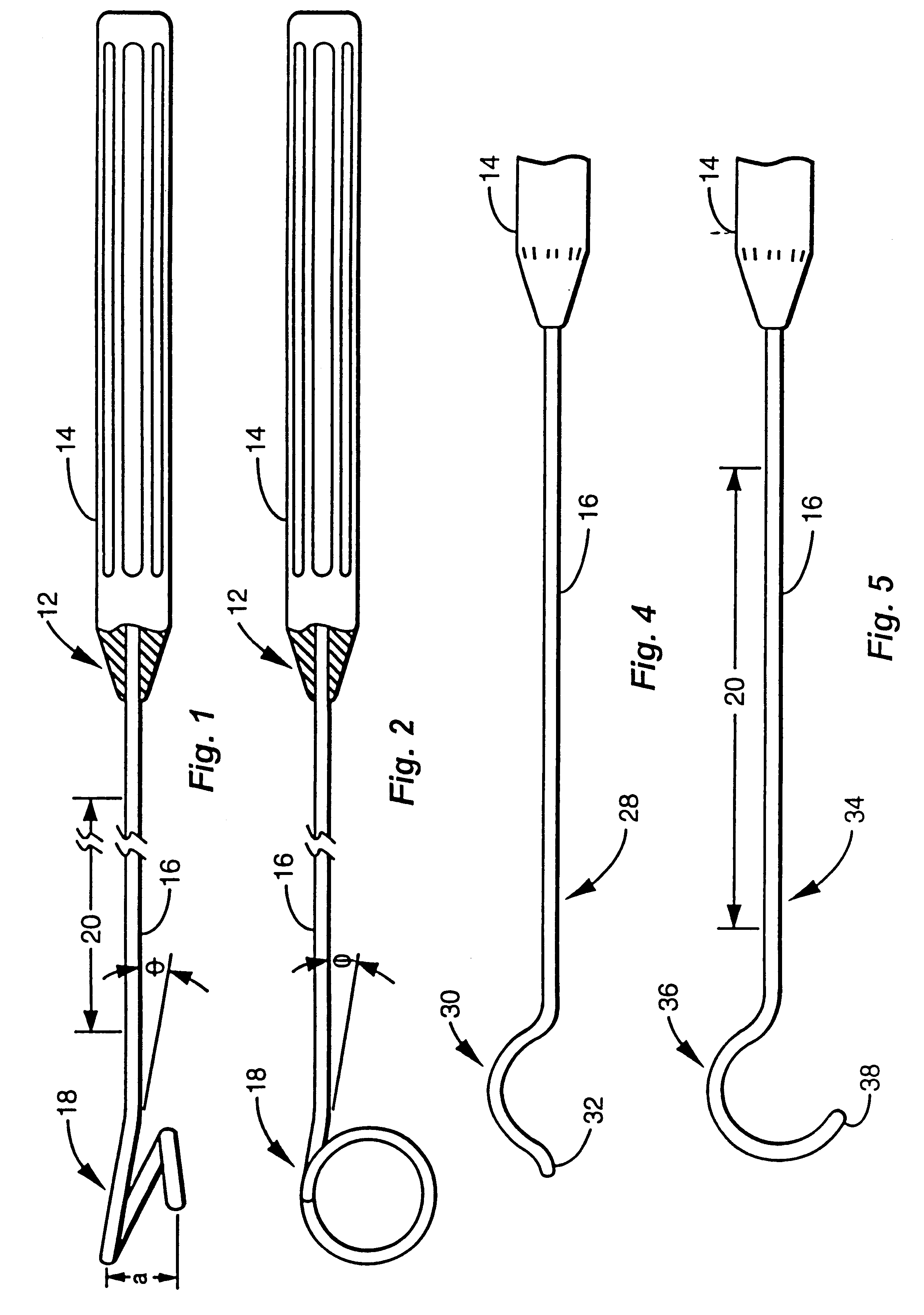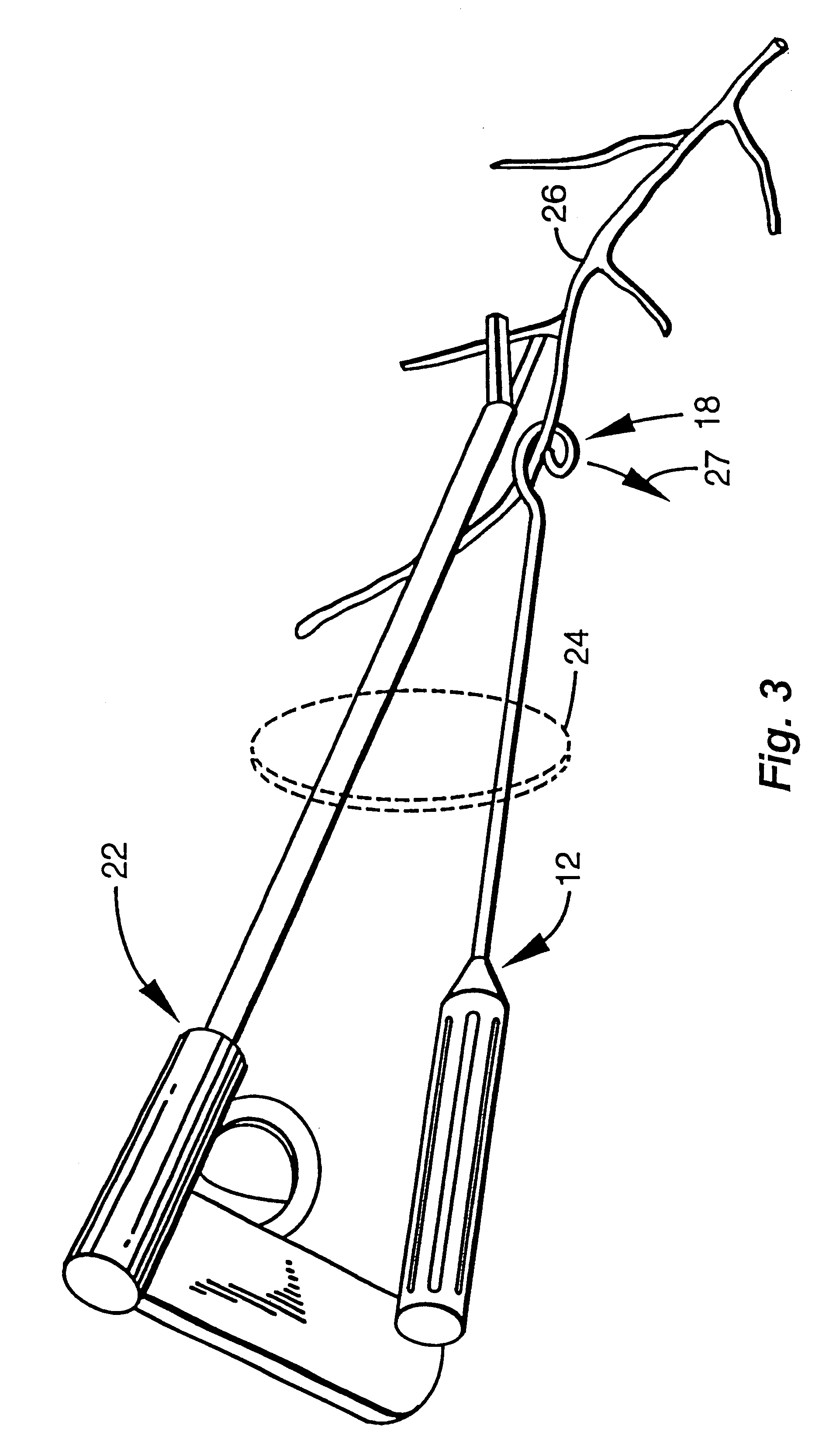Surgical instrument for facilitating the detachment of an artery and the like
a technology of surgical instruments and arteries, applied in the field of surgical instruments for facilitating the detachment of arteries, can solve the problems of unspecified instruments, complex and difficult harvesting of ima, and further complicated procedure of cabgs
- Summary
- Abstract
- Description
- Claims
- Application Information
AI Technical Summary
Benefits of technology
Problems solved by technology
Method used
Image
Examples
embodiment 12
FIG. 3 illustrates a manner of use of the invention employing FIGS. 1 and 2. It is to be understood that any of the embodiments presented herein also may be used in similar fashion to perform the same function. To this end, surgical scissors 22 may be introduced by a surgeon through a thoracotomy 24 and used to initiate the severing of tissues from a vessel such as an IMA 26 to thus initiate detachment of a first segment of the IMA. In the following description, the IMA is used as the example, with the understanding that other vessels may be harvested using the devices and procedures of the invention. Upon slight detachment of the IMA, instrument 12 of the invention also is inserted through the thoracotomy 24 and the tip 19 of loop 18 is introduced past IMA 26. A slight twist of instrument 12 causes loop 18 to encircle the IMA whereupon the surgeon has complete control of the direction in which force may be applied to urge the IMA gently from its native location. Scissors 22 simulta...
embodiment 28
FIG. 4 illustrates an alternative embodiment 28 of the invention, wherein the full loop 18 of the FIGS. 1 and 2 is defined by one or more arcuate segments, which comprise at least one arc 30 formed in the distal end of rod 16. Arc 30 terminates in a tip 32 which is bent away from the arc configuration to extend generally coaxially with rod 16. Tip 32 guides the introduction of arc 30 through the surrounding tissues and past the IMA, whereby arc 30 is used to manipulate the IMA while detaching it from the endothoracic fascia.
embodiment 34
FIG. 5 illustrates a further alternative embodiment 34 of the invention, wherein the loop 18 of FIGS. 1 and 2 is defined by a slightly ovaled partial loop 36 of approximately three-fourths of a full oval or circle. This configuration provides a tip 38 which allows manipulating the IMA in various directions without completely encircling the artery as with loop 18. As depicted in FIG. 5, rod 16 may be annealed along a length 20 as described in FIG. 1, to allow readily deforming the rod to tailor the contour of the instrument to meet the requirements of the procedure, the anatomy of the patient, and the preferences of the surgeon to facilitate the capture and manipulation of the IMA by loop 18, arc 30 or partial loop 36.
FIGS. 6-9 depict portions of alternative embodiments 40 of the invention employing a retractable distal working end of the instrument. Rod 16 and loop 18 (or arc 30 or partial loop 36) may be retracted into a protective housing when not in use, and extended to provide l...
PUM
 Login to View More
Login to View More Abstract
Description
Claims
Application Information
 Login to View More
Login to View More - R&D
- Intellectual Property
- Life Sciences
- Materials
- Tech Scout
- Unparalleled Data Quality
- Higher Quality Content
- 60% Fewer Hallucinations
Browse by: Latest US Patents, China's latest patents, Technical Efficacy Thesaurus, Application Domain, Technology Topic, Popular Technical Reports.
© 2025 PatSnap. All rights reserved.Legal|Privacy policy|Modern Slavery Act Transparency Statement|Sitemap|About US| Contact US: help@patsnap.com



